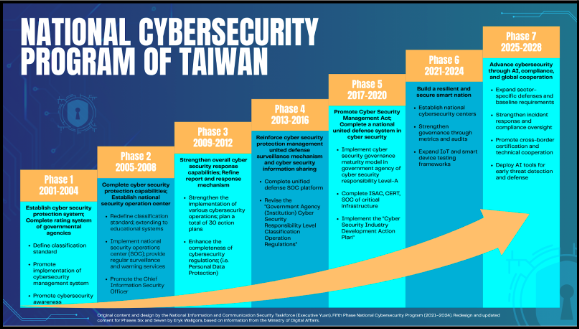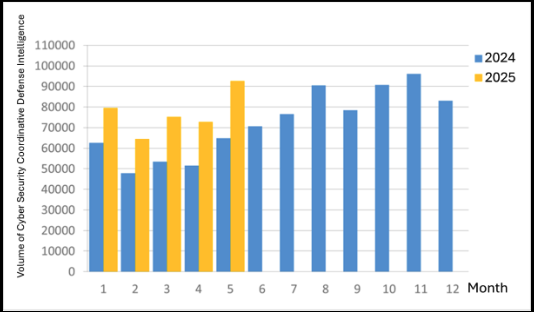
In May 2025, Taiwan announced the seventh phase of its National Cybersecurity Development Program (spanning 2025-2028), a four-year blueprint that directs NTD 8.8 billion (USD 301 million) in new resources towards countering intensifying cyber campaigns and safeguarding Taiwan’s role in global technology supply chains. This seventh phase sets higher benchmarks for sector-level readiness, expands public-private coordination, and introduces artificial intelligence (AI) tools for early threat detection, signaling Taipei’s urgent commitment to modernizing its defenses in response to mounting cyber threats.
Taiwan’s earlier program phases, dating back to 2001, concentrated on infrastructure hardening, security audits, and public awareness. These efforts built the foundation for a centralized governance model, but they were often hindered by siloed implementation and limited visibility across agencies. A major milestone in strengthening institutional oversight came with the passage of the Cybersecurity Management Act in 2018, which established legal obligations for government agencies and critical infrastructure providers to maintain cybersecurity standards. However, even with the Act in place, challenges persisted due to inconsistent enforcement and limited interagency coordination. Over time, intensifying threats and internal coordination gaps have prompted a move from a reactive defense towards targeted resilience and proactive planning.

Image: National Cybersecurity Program of Taiwan. (Image Source: Original content and design by the National Information and Communication Security Taskforce (Executive Yuan), Fifth Phase National Cybersecurity Program (2021-2024). Redesign and updated content for Phases Six and Seven by Eryk Waligora, based on information from the Ministry of Digital Affairs.)
A Strategic Shift in National Cybersecurity Planning
Approved by the Executive Yuan (行政院) and coordinated by the Ministry of Digital Affairs (MODA, 數位發展部), the seventh phase expands the mandate of MODA’s Administration for Cyber Security (ACS) and brings more than a dozen ministries under a unified implementation approach. This phase attempts to recalibrate Taiwan’s national response based on operational lessons and increased regional vulnerability.
MODA has structured the plan around four pillars: (1) national preparedness, (2) infrastructure risk reduction, (3) cybersecurity industry development, and (4) AI application. Each pillar reflects an area where Taiwan has previously struggled to integrate cyber policy into broader institutional frameworks.
The first pillar centers on building a more distributed approach to national preparedness. For the first time, local governments, public schools, and nonprofit institutions are included as formal participants in Taiwan’s national cybersecurity planning. MODA is funding more than 150 annual scholarships, expanding technical training programs, and establishing certification pipelines to embed cybersecurity talent into Taiwan’s wider development agenda. This expansion demonstrates a strategic move toward decentralized risk ownership. It recognizes that cyber resilience requires not only national coordination but also localized capability and accountability across all levels of society.
The second pillar focuses on reducing sector-specific infrastructure risk. MODA and the ACS will issue tailored baseline security standards and conduct live simulation exercises to test operational readiness. Sectors such as energy, healthcare, and telecommunications remain central to this effort due to their high exposure to cyberattacks and their critical roles in providing essential services. This pillar is a direct response to Taiwan’s longstanding structural weaknesses in inter-agency oversight and uneven adoption of protective measures, which have historically left key sectors vulnerable to disruption.
The third pillar strengthens Taiwan’s international competitiveness by aligning its cybersecurity industry with global technical standards. A key initiative is TSMC’s collaboration with a leading electronics industry association, SEMI, on the SEMI E187 standard, which establishes minimum cybersecurity requirements for semiconductor equipment suppliers. With TSMC accounting for over 67 percent of the global semiconductor market, this measure is not only operationally significant but strategically necessary. It reveals a policy shift linking national security to export resilience and supply chain trustworthiness, reinforcing Taiwan’s credibility as a secure and indispensable technology partner.
The fourth pillar introduces artificial intelligence as a core component of Taiwan’s national cybersecurity strategy. MODA will deploy AI-driven tools for anomaly detection, behavioral analytics, and predictive threat modeling, aiming to enhance response speed and precision. This marks a calculated shift, moving AI from a supporting role to a central function in Taiwan’s defense planning. These tools will also strengthen core defense operations through automated malware analysis, cross-agency threat intelligence sharing, and faster mitigation of zero-day vulnerabilities. Together, these expanded capabilities highlight Taiwan’s push to modernize its cyber defenses through real-time data analysis and scalable automation.
Why This Shift Matters
The redesign of Taiwan’s cybersecurity approach stems from a regional context of persistent threat escalation. For decades, Taiwan has been subject to coordinated campaigns that blend espionage, infrastructure targeting, and disinformation. These campaigns are often intended to test institutional boundaries and erode public confidence, requiring not only technical defenses, but resilient civic architecture. In recent years, this reality has prompted successive administrations to amplify the message that cybersecurity is inseparable from national security, a principle first articulated by former President Tsai Ing-wen (蔡英文) in 2019, and most recently reiterated by President Lai Ching-te (賴清德) at CYBERSEC 2025 in April. Yet, despite growing political recognition of its importance, cybersecurity policy execution has often failed to match progress in these ambitions. Under earlier programs, gaps in inter-agency coordination and unclear roles for sectoral regulators hampered implementation.
Efforts to address these shortcomings come at a critical time, as Taiwan continues to face a surge in cyber threat and operational strain across its digital infrastructure. The ACS’ Cybersecurity Monthly Report for May 2025 provides a timely reference point to assess the scale and persistence of these challenges. MODA reported 8,655 cybersecurity incidents in May, a 13.7 percent increase from the 7,611 recorded in April. Compared to May 2024, when 7,647 incidents were recorded, this marks a year-on-year rise of 13.2 percent. The data affirms a consistent rise in hostile cyber activity, much of it exploiting weaknesses in central and local government systems. Nearly 60 percent of these incidents reported by MODA involved phishing or malicious link activity.

Figure: Statistics of information security joint defense monitoring and information security monitoring intelligence. (Figure Source: Ministry of Digital Affairs)
The above chart further illustrates fluctuations in monthly incident reporting. The upward trend reinforces the importance of adaptive monitoring and response systems. It also points to a dual dynamic: the increase in reported incidents may indicate both growing threat sophistication and improved detection capabilities. The timing of the seventh phase’s announcement in May, coinciding with heightened incident volume, underscores the urgency and relevance of the program’s new priorities. This convergence makes it clear why investments in distributed preparedness, sector-specific baselines, and AI-integrated threat detection are not only timely, but essential.
From Domestic Defense to Global Engagement
Taiwan’s seventh phase is also intended to support critical alignment with partners who share its democratic and technological values. MODA has prioritized bilateral and multilateral engagements that enhance mutual readiness, particularly in areas such as cross-border product assurance, AI governance, and cyber workforce development.
This cohesion is most clearly reflected in Taiwan’s well established strategic partnership with the United States. The seventh phase builds on earlier US-Taiwan cooperation in semiconductors, incident response, and information sharing, offering new momentum for formalizing collaboration through annual joint cyber exercises and a recurring technical standards working group. By incorporating bilateral criteria and technical certifications into its national strategy, Taiwan strengthens its role as a reputable partner, capable of meeting security benchmarks across key technologies. This approach is increasingly relevant as both governments evaluate AI-integration and infrastructure protection as core elements of regional stability.
Yet, policy alignment is not automatic. While Taiwan already recognizes internationally accepted frameworks such as NIST 800-53 and ISO 27001, and publishes audit trails through MODA’s public website, these practices need to be applied uniformly across every ministry. Joint threat modeling workshops with US agencies and private-sector partners should also be expanded and institutionalized. MODA’s stated commitment to transparency must now translate into consistent, measurable outcomes that partners can rely on.
To support these goals, Taiwan is expanding collaborative research and cultivating cyber diplomacy channels with US stakeholders, including the National Science Foundation, the Department of Homeland Security’s Cybersecurity and Infrastructure Security Agency (CISA), and leading academic institutions. New opportunities for joint simulations, coordinated certification efforts, and security-by-design initiatives can strengthen these relationships. US agencies and lawmakers can further support this momentum by codifying planning efforts, increasing technical exchanges, and encouraging sustained recognition of vendor qualifications to improve cross-border supply chain reliability. These measures bolster Taiwan’s position as a good-faith partner in a region where cybersecurity is increasingly linked to geopolitical stability and democratic resilience.
Conclusion
The seventh phase of the National Cybersecurity Development Program represents a structural realignment of Taiwan’s national defense priorities. By integrating AI into core defense functions, advancing supply chain protections, and elevating readiness across government and industry, the program reflects a maturing approach to national cybersecurity. It also presents a practical roadmap for cooperation with like-minded partners seeking to strengthen collective defenses in an increasingly contested digital environment. To deepen the program’s strategic impact, Taiwan and its partners should expand technical cooperation, jointly develop AI-powered cybersecurity solutions, and establish shared certification protocols that build trust, improve readiness, and fortify regional cyber defenses.
The main point: Taiwan’s seventh phase (2025-2028) of the National Cybersecurity Development Program signals a decisive transformation in its national defense posture. By embedding AI capabilities, hardening supply chains, and reforming institutions, the program positions Taiwan to lead on cyber readiness in Asia and to serve as a vital security partner in preserving democratic stability across the Indo-Pacific.


